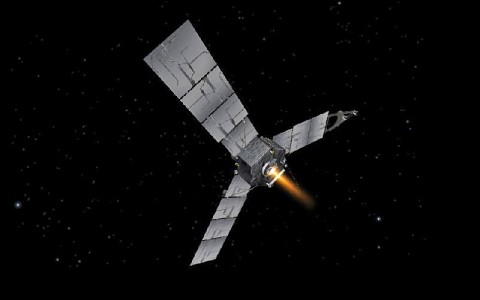 Pasadena, CA – NASA’s Juno spacecraft is halfway to Jupiter. The Jovian-system-bound spacecraft reached the milestone August 12th, 2013 at 5:25am PDT (8:25am EDT/12:25 UTC).
Pasadena, CA – NASA’s Juno spacecraft is halfway to Jupiter. The Jovian-system-bound spacecraft reached the milestone August 12th, 2013 at 5:25am PDT (8:25am EDT/12:25 UTC).
“Juno’s odometer just clicked over to 9.464 astronomical units,” said Juno Principal Investigator Scott Bolton, of the Southwest Research Institute in San Antonio, TX. “The team is looking forward, preparing for the day we enter orbit around the most massive planet in our solar system.”

The 9.464 astronomical units Juno has already traveled (or still has left to go) is equivalent to 879,733,760 miles (or 1,415,794,248 kilometers). Juno was 34.46 million miles (55.46 million kilometers) from Earth when the milestone was reached.
The next milestone in the nearly five-year journey to Jupiter will occur this October, when the spacecraft flies past Earth in search of a little extra speed.
“On October 9th, Juno will come within 347 miles (559 kilometers) of Earth,” said the mission’s Project Manager Rick Nybakken of NASA’s Jet Propulsion Laboratory in Pasadena, Calif. “The Earth flyby will give Juno a kick in the pants, boosting its velocity by 16,330 mph (about 7.3 kilometers per second). From there, it’s next stop Jupiter.”
Juno will arrive at Jupiter on July 4th, 2016, at 7:29pm PDT (10:29pm EDT).
Juno was launched on August 5th, 2011. Once in orbit around Jupiter, the spacecraft will circle the planet 33 times, from pole to pole, and use its collection of eight science instruments to probe beneath the gas giant’s obscuring cloud cover. Juno’s science team will learn about Jupiter’s origins, structure, atmosphere and magnetosphere, and look for a potential solid planetary core.
Juno’s name comes from Greek and Roman mythology. The god Jupiter drew a veil of clouds around himself to hide his mischief, and his wife, the goddess Juno, was able to peer through the clouds and reveal Jupiter’s true nature.
NASA’s Jet Propulsion Laboratory, Pasadena, CA, manages the Juno mission for the principal investigator, Scott Bolton, of Southwest Research Institute in San Antonio. The Juno mission is part of the New Frontiers Program managed at NASA’s Marshall Space Flight Center in Huntsville, AL. Lockheed Martin Space Systems, Denver, CO, built the spacecraft. JPL is a division of the California Institute of Technology in Pasadena.
More information about Juno is online at http://www.nasa.gov/juno and http://missionjuno.swri.edu .
Written by DC Agle
NASA’s Jet Propulsion Laboratory, Pasadena, CA


